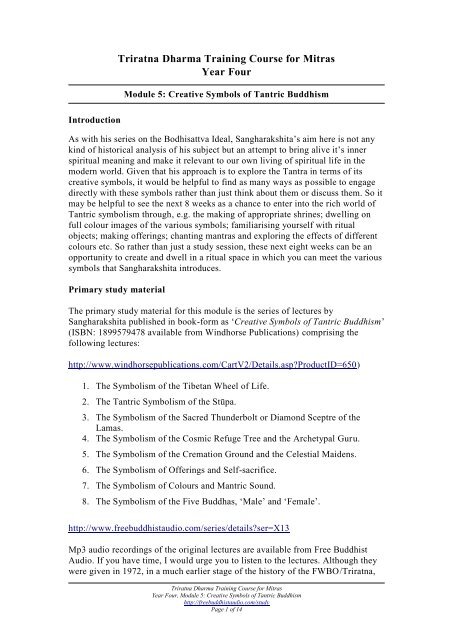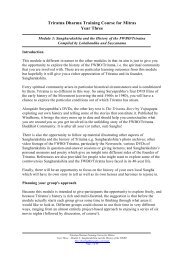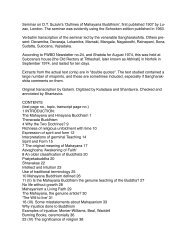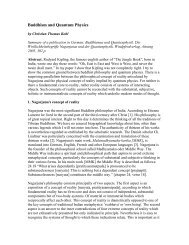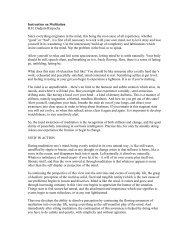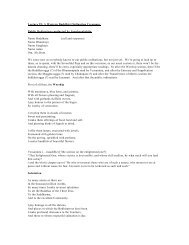Creative Symbols of Tantric Buddhism - Free Buddhist Audio
Creative Symbols of Tantric Buddhism - Free Buddhist Audio
Creative Symbols of Tantric Buddhism - Free Buddhist Audio
Create successful ePaper yourself
Turn your PDF publications into a flip-book with our unique Google optimized e-Paper software.
Triratna Dharma Training Course for Mitras<br />
Year Four<br />
Module 5: <strong>Creative</strong> <strong>Symbols</strong> <strong>of</strong> <strong>Tantric</strong> <strong>Buddhism</strong><br />
Introduction<br />
As with his series on the Bodhisattva Ideal, Sangharakshita’s aim here is not any<br />
kind <strong>of</strong> historical analysis <strong>of</strong> his subject but an attempt to bring alive it’s inner<br />
spiritual meaning and make it relevant to our own living <strong>of</strong> spiritual life in the<br />
modern world. Given that his approach is to explore the Tantra in terms <strong>of</strong> its<br />
creative symbols, it would be helpful to find as many ways as possible to engage<br />
directly with these symbols rather than just think about them or discuss them. So it<br />
may be helpful to see the next 8 weeks as a chance to enter into the rich world <strong>of</strong><br />
<strong>Tantric</strong> symbolism through, e.g. the making <strong>of</strong> appropriate shrines; dwelling on<br />
full colour images <strong>of</strong> the various symbols; familiarising yourself with ritual<br />
objects; making <strong>of</strong>ferings; chanting mantras and exploring the effects <strong>of</strong> different<br />
colours etc. So rather than just a study session, these next eight weeks can be an<br />
opportunity to create and dwell in a ritual space in which you can meet the various<br />
symbols that Sangharakshita introduces.<br />
Primary study material<br />
The primary study material for this module is the series <strong>of</strong> lectures by<br />
Sangharakshita published in book-form as ‘<strong>Creative</strong> <strong>Symbols</strong> <strong>of</strong> <strong>Tantric</strong> <strong>Buddhism</strong>’<br />
(ISBN: 1899579478 available from Windhorse Publications) comprising the<br />
following lectures:<br />
http://www.windhorsepublications.com/CartV2/Details.asp?ProductID=650)<br />
1. The Symbolism <strong>of</strong> the Tibetan Wheel <strong>of</strong> Life.<br />
2. The <strong>Tantric</strong> Symbolism <strong>of</strong> the Stūpa.<br />
3. The Symbolism <strong>of</strong> the Sacred Thunderbolt or Diamond Sceptre <strong>of</strong> the<br />
Lamas.<br />
4. The Symbolism <strong>of</strong> the Cosmic Refuge Tree and the Archetypal Guru.<br />
5. The Symbolism <strong>of</strong> the Cremation Ground and the Celestial Maidens.<br />
6. The Symbolism <strong>of</strong> Offerings and Self-sacrifice.<br />
7. The Symbolism <strong>of</strong> Colours and Mantric Sound.<br />
8. The Symbolism <strong>of</strong> the Five Buddhas, ‘Male’ and ‘Female’.<br />
http://www.freebuddhistaudio.com/series/details?ser=X13<br />
Mp3 audio recordings <strong>of</strong> the original lectures are available from <strong>Free</strong> <strong>Buddhist</strong><br />
<strong>Audio</strong>. If you have time, I would urge you to listen to the lectures. Although they<br />
were given in 1972, in a much earlier stage <strong>of</strong> the history <strong>of</strong> the FWBO/Triratna,<br />
Triratna Dharma Training Course for Mitras<br />
Year Four, Module 5: <strong>Creative</strong> <strong>Symbols</strong> <strong>of</strong> <strong>Tantric</strong> <strong>Buddhism</strong><br />
http://freebuddhistaudio.com/study<br />
Page 1 <strong>of</strong> 14
the inspiration and sense <strong>of</strong> occasion come across much better when you can hear<br />
Sangharakshita rather than just read the words from a printed page. Please be<br />
aware that the book has more material in it as excerpts from seminars have been<br />
edited into it.<br />
Study guide and suggested questions<br />
As with the other modules, the suggested questions are here to help you engage<br />
with the main points in the text. You may wish to read them before reading the<br />
text so that you can focus your reading and reflection. However, the questions are<br />
not likely to be definitive so if there are other issues or questions you have, feel<br />
free to raise them in your group.<br />
Triratna Dharma Training Course for Mitras<br />
Year Four, Module 5: <strong>Creative</strong> <strong>Symbols</strong> <strong>of</strong> <strong>Tantric</strong> <strong>Buddhism</strong><br />
http://freebuddhistaudio.com/study<br />
Page 2 <strong>of</strong> 14
Unit 1: The Symbolism <strong>of</strong> the Tibetan Wheel <strong>of</strong> Life<br />
For this unit, you will need to read both the Introduction and Chapter 1 – The<br />
Tibetan Wheel <strong>of</strong> Life. The symbol <strong>of</strong> the Wheel <strong>of</strong> Life has already featured in<br />
Part 4, Week 3 <strong>of</strong> the Foundation Year but here Sangharakshita explores it in<br />
greater depth and in the context <strong>of</strong> <strong>Tantric</strong> symbolism.<br />
1. What is a symbol? How does it differ from a sign or a concept? Give an<br />
example <strong>of</strong> an important symbol from your own life.<br />
2. How can you develop receptivity to the symbols <strong>of</strong> the <strong>Tantric</strong> path that we<br />
will be exploring? Give one or two specific examples <strong>of</strong> things you could<br />
do over the next 8 weeks.<br />
3. When you look into the mirror <strong>of</strong> the Wheel <strong>of</strong> Life, which <strong>of</strong> its many<br />
images strikes you most strongly? Why do you think this image speaks to<br />
you so strongly?<br />
4. The six realms represent habitual ways <strong>of</strong> being that we all inhabit from<br />
time to time. Which <strong>of</strong> the realms do you feel most familiar with? Describe<br />
that realm from your own experience. You could also ask a friend which<br />
realm they think you dwell in most and see if your answers correspond!<br />
Are there any realms that you feel completely unfamiliar with?<br />
5. What does the Buddha’s <strong>of</strong>fering in that realm tell you about how you can<br />
work with your mental states to free yourself from that realm? What would<br />
be a concrete example <strong>of</strong> the Buddha’s advice for you? Try putting it into<br />
practice over the coming week, noticing what effect it has.<br />
6. Do the Buddha’s <strong>of</strong>ferings in the realms give you any ideas as to how you<br />
might respond more helpfully to other people dwelling in those realms?<br />
7. What conclusions can you draw from the teaching <strong>of</strong> the Buddha seeds and<br />
how these are distributed through the six realms?<br />
8. Why is the image <strong>of</strong> the hare in the moon so important?<br />
Triratna Dharma Training Course for Mitras<br />
Year Four, Module 5: <strong>Creative</strong> <strong>Symbols</strong> <strong>of</strong> <strong>Tantric</strong> <strong>Buddhism</strong><br />
http://freebuddhistaudio.com/study<br />
Page 3 <strong>of</strong> 14
Unit 2: The <strong>Tantric</strong> Symbolism <strong>of</strong> the Stūpa<br />
You will have encountered the symbol <strong>of</strong> the stūpa already if you studied ‘The<br />
Drama <strong>of</strong> Cosmic Enlightenment’ in Year Three <strong>of</strong> the course. Unit 6 <strong>of</strong> that<br />
module – ‘Five Element Symbolism and the Stūpa’ – covers similar, but not<br />
identical, ground to this unit. Please read Chapter Two – The <strong>Tantric</strong> Stūpa before<br />
your group meeting.<br />
1. Look for images <strong>of</strong> stūpas (on the web or in books) – what is your response<br />
to them? Which aspects <strong>of</strong> them, if any, have significance for you? Bring<br />
any images you do find to the group session to share with others.<br />
2. What is rūpa? What do you understand by the term ‘objective content <strong>of</strong><br />
the perceptual situation’?<br />
3. What is the function <strong>of</strong> initiation? What place does it have within Triratna?<br />
Have you had an experience <strong>of</strong> your ‘dormant psycho-spiritual energies’<br />
being activated in any way?<br />
4. Try painting or making a simple stūpa and notice your response to the<br />
different elements <strong>of</strong> it.<br />
5. Set aside some time during the week to notice the different elements, both<br />
in your own experience and in the world around you. If you have time,<br />
write something about each element.<br />
Triratna Dharma Training Course for Mitras<br />
Year Four, Module 5: <strong>Creative</strong> <strong>Symbols</strong> <strong>of</strong> <strong>Tantric</strong> <strong>Buddhism</strong><br />
http://freebuddhistaudio.com/study<br />
Page 4 <strong>of</strong> 14
Unit 3: The Symbolism <strong>of</strong> the Sacred Thunderbolt<br />
or Diamond Sceptre <strong>of</strong> the Lamas<br />
Here, Sangharakshita introduces us to the vajra or diamond thunderbolt, after<br />
which the Vajrayāna is itself named. Please read Chapter Three – The Sacred<br />
Thunderbolt before your group meeting.<br />
1. What is your response to the symbol <strong>of</strong> the vajra?<br />
2. In what ways is the vajra a symbol for reality?<br />
3. How do you respond to the figure <strong>of</strong> wrathful Vajrapāṇi?<br />
4. ‘Any shattering experience has an element <strong>of</strong> reality in it. If an experience<br />
shatters, it is real – and if it doesn’t shatter us, its authenticity may be<br />
questioned.’ (p 59).<br />
Have you had any experience that you would call shattering? If so, what led<br />
up to it and what were its effects on you?<br />
5. ‘There is certainly room for a great deal more intensity in the spiritual<br />
practice <strong>of</strong> most Western <strong>Buddhist</strong>s’ (p. 60).<br />
What could you do to intensify your own spiritual practice?<br />
6. Why do you think the symbol <strong>of</strong> the vajra is so central to <strong>Tantric</strong><br />
<strong>Buddhism</strong>?<br />
7. Vajrasattva – ‘the being <strong>of</strong> the vajra’ – is strongly associated with purity –<br />
why should this be so? What are your own associations with purity? How<br />
do you respond to the figure <strong>of</strong> Vajrasattva?<br />
Triratna Dharma Training Course for Mitras<br />
Year Four, Module 5: <strong>Creative</strong> <strong>Symbols</strong> <strong>of</strong> <strong>Tantric</strong> <strong>Buddhism</strong><br />
http://freebuddhistaudio.com/study<br />
Page 5 <strong>of</strong> 14
Unit 4: The Symbolism <strong>of</strong> the Cosmic Refuge Tree and the Archetypal Guru<br />
The module ‘Wisdom Teachings from the Refuge Tree’ in Year Four <strong>of</strong> the<br />
Dharma Training Course introduces and explores the symbol <strong>of</strong> the Triratna<br />
Refuge Tree. Here, we will be looking at the traditional Nyingmapa version <strong>of</strong> the<br />
Refuge Tree as this was the version <strong>of</strong> the practice that Sangharakshita was given<br />
by Khachu Rimpoche when he lived in Kalimpong. (See Precious Teachers, p.85).<br />
The role <strong>of</strong> the guru is also explored in Sangharakshita’s lecture ‘Is a Guru<br />
Necessary?’<br />
http://www.freebuddhistaudio.com/talks/details?num=90<br />
This is studied in the Year Two module on ‘What is the Sangha?’ Please read<br />
chapter 14 <strong>of</strong> the book before your group meeting.<br />
1. What is the difference between escape and escapism? Are there any<br />
elements <strong>of</strong> escapism in your own approach to the Dharma?<br />
2. What might the esoteric refuges be in your own life? Talk about this with a<br />
good friend and see if they agree with you!<br />
3. ‘...but within it (the Sangha) there may be just a few people whose company<br />
you find so stimulating that they can be the third esoteric refuge for you’<br />
(p. 89).<br />
Are there any people in your life like this?<br />
4. Why don’t we have gurus in Triratna? Should we have them?<br />
5. What is a spiritual lineage? What is transmitted within it? What might it<br />
mean in the context <strong>of</strong> Triratna? Do you feel part <strong>of</strong> a spiritual lineage<br />
yourself?<br />
6. ‘...all life is participating in this great process, the cosmic Going for<br />
Refuge’ (p. 98).<br />
What does this phrase ‘Cosmic Going for Refuge’ mean to you? How could<br />
you cultivate a stronger sense <strong>of</strong> it in your own life?<br />
Triratna Dharma Training Course for Mitras<br />
Year Four, Module 5: <strong>Creative</strong> <strong>Symbols</strong> <strong>of</strong> <strong>Tantric</strong> <strong>Buddhism</strong><br />
http://freebuddhistaudio.com/study<br />
Page 6 <strong>of</strong> 14
Unit 5: The Symbolism <strong>of</strong> the Cremation Ground and the Celestial Maidens<br />
This is a very rich lecture looking at some <strong>of</strong> our deepest fears and how we can<br />
confront them. Through doing this, we can begin to transform our deepest and<br />
most powerful emotions, liberating the energy held in them for our spiritual<br />
practice. Please read Chapter Five – The Cremation Ground and the Celestial<br />
Maidens before your group meeting.<br />
1. Have you had any close encounters with death? e.g. have you been close to<br />
death yourself?<br />
Have you been with someone else when they have died?<br />
Have you seen a corpse? If so, what has been your response to these<br />
situations?<br />
What has been your experience <strong>of</strong> funerals? Have you been to a <strong>Buddhist</strong><br />
funeral?<br />
2. Keep a journal for each day this week in which you write down all the<br />
experiences <strong>of</strong> impermanence that you notice.<br />
3. What situations give rise to fear within you? What attempts have you made<br />
to face your own fears?<br />
4. ‘If you are going to teach the ḍākinīs, you have to find them first’ (p. 122).<br />
Have you found that your spiritual life has begun to free up your energies?<br />
If so, how and in what way? Are there any other things you can do to free<br />
your energies?<br />
5. ‘In fact, in all forms <strong>of</strong> <strong>Buddhism</strong>, great importance is attached to the<br />
heroic virtues: courage, self-confidence, self-reliance, energy, initiative.’<br />
(p. 115).<br />
How are these virtues relevant to your own practice <strong>of</strong> <strong>Buddhism</strong>?<br />
6. Sangharakshita suggests ‘The symbolism <strong>of</strong> the ḍākinī thus <strong>of</strong>fers a way <strong>of</strong><br />
integrating one’s unconscious contents by personalizing them and<br />
conducting a dialogue with that personalized form’ (p. 124).<br />
Have you ever attempted such a dialogue? What has been the outcome if<br />
you have?<br />
7. ‘She (the ḍākinī) represents that spiritual ideal <strong>of</strong> self-abandonment to the<br />
Three Jewels’ (p. 126).<br />
What might it be like to really give yourself to the Three Jewels in this<br />
way?<br />
8. How can you distinguish between a growth promoting cremation ground<br />
and a situation that you simply can’t handle?<br />
Triratna Dharma Training Course for Mitras<br />
Year Four, Module 5: <strong>Creative</strong> <strong>Symbols</strong> <strong>of</strong> <strong>Tantric</strong> <strong>Buddhism</strong><br />
http://freebuddhistaudio.com/study<br />
Page 7 <strong>of</strong> 14
Unit 6: The Symbolism <strong>of</strong> Offerings and Self-sacrifice<br />
This is a great exploration <strong>of</strong> the whole area <strong>of</strong> <strong>of</strong>ferings in the <strong>Buddhist</strong> tradition.<br />
Given this theme, you may want to make a practice this week <strong>of</strong> making fresh<br />
<strong>of</strong>ferings each day to your shrine at home. Please read chapter six before your<br />
group meeting.<br />
1. If you had an honoured guest coming to stay with you, what would you do<br />
to make them feel welcome?<br />
2. If you were to make your own (non-traditional) <strong>of</strong>ferings to the Buddha,<br />
what would they be?<br />
3. How can the making <strong>of</strong> <strong>of</strong>ferings function as an effective spiritual practice?<br />
When you have made <strong>of</strong>ferings, what effect has that had on you?<br />
4. Gratitude (kataññutā in Pāli) has been defined as ‘knowing and recognizing<br />
what has been done to one for one’s benefit’. Does reflecting on the<br />
benefits you have received from others help you to connect with a desire to<br />
make <strong>of</strong>ferings?<br />
5. What do you make <strong>of</strong> the symbolism <strong>of</strong> the Mandala that is <strong>of</strong>fered to the<br />
Buddha? What might it look like to make such an <strong>of</strong>fering in terms <strong>of</strong><br />
modern Western cosmology?<br />
6. ‘Egoism is not an entity, but an attitude.’ (p. 150). To what extent does the<br />
making <strong>of</strong> <strong>of</strong>ferings help you to overcome such egoism?<br />
7. How would you <strong>of</strong>fer your self to the Buddhas?<br />
8. Spend some time quietly on your own in nature, relax and try to open up to<br />
its aliveness. What do you notice when you do this?<br />
Triratna Dharma Training Course for Mitras<br />
Year Four, Module 5: <strong>Creative</strong> <strong>Symbols</strong> <strong>of</strong> <strong>Tantric</strong> <strong>Buddhism</strong><br />
http://freebuddhistaudio.com/study<br />
Page 8 <strong>of</strong> 14
Unit 7: The Symbolism <strong>of</strong> Colours and Mantric Sound<br />
With this week’s theme, perhaps you could recite 108 mantras <strong>of</strong> one <strong>of</strong> the<br />
Buddhas or Bodhisattvas that you feel a connection with at some point during each<br />
day. Or you could choose a colour to which you are drawn, noticing how that<br />
colour manifests in the world as well as the effects that colour has on you.<br />
1. Is colour symbolism universal or culturally specific? Explore this using<br />
some specific examples.<br />
2. What is your favourite colour? What associations does that colour have for<br />
you?<br />
3. Spend time really looking at colours in nature – e.g. flowers, the blue sky,<br />
the green <strong>of</strong> a forest. What are your emotional responses in each case? Are<br />
there any resonances with your favourite Buddha or Bodhisattva?<br />
4. What application do the four <strong>Tantric</strong> rites have, if any, to your spiritual<br />
life?<br />
5. What role does beauty play in your spiritual life? What are the advantages<br />
and dangers <strong>of</strong> being led by beauty?<br />
6. Are you inspired by the arts? By beautiful paintings? By music? How could<br />
these things be an aid to spiritual practice for you?<br />
7. How is a mantra a ‘sound symbol’?<br />
8. What is your experience <strong>of</strong> the spiritual value <strong>of</strong> mantras?<br />
Triratna Dharma Training Course for Mitras<br />
Year Four, Module 5: <strong>Creative</strong> <strong>Symbols</strong> <strong>of</strong> <strong>Tantric</strong> <strong>Buddhism</strong><br />
http://freebuddhistaudio.com/study<br />
Page 9 <strong>of</strong> 14
Unit 8: The Symbolism <strong>of</strong> the Five Buddhas, ‘Male’ and ‘Female’<br />
To conclude the series, Sangharakshita here looks at one <strong>of</strong> the richest and most<br />
important symbols <strong>of</strong> <strong>Tantric</strong> <strong>Buddhism</strong>.<br />
1. Which appeals more to you - the figure <strong>of</strong> the historical Buddha or one <strong>of</strong><br />
the archetypal Buddha forms? Why do you think that is?<br />
2. If you have time, draw two different mandalas – one a mandala <strong>of</strong> your life<br />
and the other the ideal mandala <strong>of</strong> the Five Buddhas (this last doesn’t have<br />
to be figurative but could just have the colours and/or symbols arranged in<br />
a mandala pattern with the three walls <strong>of</strong> the mandala etc.).<br />
3. Which <strong>of</strong> the five Buddhas – male or female – appeals to you most and<br />
why?<br />
4. Why do you think the five female Buddhas represent the Wisdom aspect <strong>of</strong><br />
Enlightenment and the five male Buddhas the compassion aspect?<br />
5. Write down your thoughts and associations with each <strong>of</strong> the Five Wisdoms<br />
(p. 185).<br />
6. How do you respond to the yab-yum and wrathful figures <strong>of</strong> the Mandala <strong>of</strong><br />
the Five Buddhas?<br />
Projects<br />
As with all the modules <strong>of</strong> the Dharma Training Course, this module concludes<br />
with the opportunity to present a project to your group on a topic arising from the<br />
material you have been studying. You may wish to take one <strong>of</strong> the Suggested<br />
Questions and explore it in more detail than you have been able to in the weekly<br />
meetings or you may want to take up one <strong>of</strong> the symbols we have been exploring<br />
over the last 8 weeks and go into it in more depth. Whatever you choose, the<br />
purpose <strong>of</strong> the projects is to give you the opportunity to engage with the material<br />
more fully. It is also a good way to share something <strong>of</strong> your experience with the<br />
group. If you are unsure what to do for your project, talk to your group leader.<br />
Triratna Dharma Training Course for Mitras<br />
Year Four, Module 5: <strong>Creative</strong> <strong>Symbols</strong> <strong>of</strong> <strong>Tantric</strong> <strong>Buddhism</strong><br />
http://freebuddhistaudio.com/study<br />
Page 10 <strong>of</strong> 14
Taking it Further<br />
If you have felt inspired or moved to explore any <strong>of</strong> the themes in this series<br />
further, you may find the following resources helpful. They may also be helpful<br />
for your project.<br />
Suggested further reading for the whole module<br />
Tibetan <strong>Buddhism</strong> – An Introduction by Sangharakshita (ISBN 0904766861<br />
Windhorse Publications). Chapters 6 and 7 deal with the Four Foundation Yogas<br />
and <strong>Tantric</strong> initiation.<br />
Book: http://www.windhorsepublications.com/CartV2/Details.asp?ProductID=369<br />
<strong>Audio</strong>: http://www.freebuddhistaudio.com/series/details?ser=X08<br />
A Survey <strong>of</strong> <strong>Buddhism</strong>, Sangharakshita (ISBN 0904766934 Windhorse<br />
Publications). Chapter 3 places the Tantra in the context <strong>of</strong> the development <strong>of</strong> the<br />
various Mahayana schools.<br />
http://www.windhorsepublications.com/CartV2/Details.asp?ProductID=331<br />
<strong>Buddhist</strong> Thought by Anthony Tribe, Paul Williams and Anthony Wynne (ISBN<br />
0415207010 Routledge). Chapter 7 on the Tantra gives an up-to-date academic<br />
overview <strong>of</strong> the Tantra. Anthony Tribe also has the Order name <strong>of</strong> Anandajyoti.<br />
http://www.routledge.com/books/<strong>Buddhist</strong>-Thought-isbn9780415207010<br />
Foundations <strong>of</strong> Tibetan Mysticism, Lama Anagarika Govinda (various editions).<br />
Explores various Tibetan teachings and practices through the mantra Om Mani<br />
Padme Hum. Govinda was a good friend <strong>of</strong> Sangharakshita’s.<br />
http://tinyurl.com/cln8kh<br />
The Way <strong>of</strong> the White Clouds, Lama Anagarika Govinda (various editions). A<br />
passionate and inspired narrative <strong>of</strong> his pilgrimage in Tibet where he describes<br />
eloquently his great joy at the beautiful colours and dramatic landscapes there.<br />
http://tinyurl.com/chpprr<br />
Meeting the Buddhas by Vessantara (Windhorse Publications various editions).<br />
Part 4 explores the Tantra and <strong>Tantric</strong> deities.<br />
http://www.windhorsepublications.com/CartV2/Details.asp?ProductID=335<br />
Unit 1<br />
‘Journey to Il Convento’ and ‘St Jerome Revisited’ in The Priceless Jewel by<br />
Sangharakshita (ISBN 0904766586 Windhorse Publications). These two short<br />
Triratna Dharma Training Course for Mitras<br />
Year Four, Module 5: <strong>Creative</strong> <strong>Symbols</strong> <strong>of</strong> <strong>Tantric</strong> <strong>Buddhism</strong><br />
http://freebuddhistaudio.com/study<br />
Page 11 <strong>of</strong> 14
essays explore Sangharakshita’s response to Christian religious art and his<br />
exploration <strong>of</strong> the faculty <strong>of</strong> the Imagination.<br />
Book (free download): http://www.sangharakshita.org/online_books.html<br />
<strong>Audio</strong>: Journey to Il Convento –<br />
http://www.freebuddhistaudio.com/talks/details?num=163<br />
St. Jerome Revisited: http://www.freebuddhistaudio.com/talks/details?num=164<br />
The Wheel <strong>of</strong> Life by Kulananda (ISBN 1899579303 Windhorse Publications). A<br />
short but clear overview <strong>of</strong> the Wheel <strong>of</strong> Life.<br />
http://www.windhorsepublications.com/CartV2/Details.asp?ProductID=470<br />
The Wheel <strong>of</strong> Birth and Death by Bhikkhu Khantipalo, The Wheel Publication<br />
Nos. 147/148/149, available from Access to Insight website. This gives a fuller<br />
historical background to the Wheel in the Pāli tradition.<br />
http://www.accesstoinsight.org/lib/authors/khantipalo/wheel147.html<br />
The <strong>Buddhist</strong> Vision by Subhuti (ISBN 1899579362 Windhorse Publications). This<br />
is an excellent exploration <strong>of</strong> the whole <strong>Buddhist</strong> Path using the symbols <strong>of</strong> the<br />
Wheel <strong>of</strong> Life, the Spiral Path and the Five Buddha Mandala. He is particularly<br />
good on the mental states that create each realm.<br />
http://www.windhorsepublications.com/CartV2/Details.asp?ProductID=491<br />
Unit 2<br />
Psycho-cosmic Symbolism <strong>of</strong> the Stūpa by Lama Anagarika Govinda (ISBN<br />
0913546364 Dharma Publishing). Explores the proportions and symbolism <strong>of</strong><br />
various kinds <strong>of</strong> <strong>Buddhist</strong> stūpa.<br />
http://www.wisdom-books.com/ProductDetail.asp?PID=1063<br />
<strong>Buddhist</strong> Saints in India by Reginald Ray (ISBN 0195134834 Oxford). Chapter 10<br />
explores what Ray calls the ‘cult <strong>of</strong> the stūpa’ in <strong>Buddhist</strong> history and practice.<br />
http://www.oup.com/uk/catalogue/?ci=9780195134834<br />
http://tinyurl.com/dhsmky (U.S. version)<br />
Unit 3<br />
The Vajra and the Bell by Vessantara (ISBN 1899579419 Windhorse<br />
Publications). A concise exploration <strong>of</strong> the symbolism <strong>of</strong> vajra and bell written in<br />
an approachable and direct style.<br />
Triratna Dharma Training Course for Mitras<br />
Year Four, Module 5: <strong>Creative</strong> <strong>Symbols</strong> <strong>of</strong> <strong>Tantric</strong> <strong>Buddhism</strong><br />
http://freebuddhistaudio.com/study<br />
Page 12 <strong>of</strong> 14
http://www.windhorsepublications.com/CartV2/Details.asp?ProductID=501<br />
Unit 4<br />
The Refuge Tree by Aloka (Padmaloka Books). A detailed exploration <strong>of</strong> the<br />
Nyingmapa Refuge Tree based on talks given by Aloka at Padmaloka.<br />
http://www.padmaloka.org.uk/shopbooklets.html<br />
The Refuge Tree as Mythic Context by Aloka (Padmaloka Books). A more<br />
practical guide to engaging with the various images and symbols that make up the<br />
Refuge Tree.<br />
http://www.padmaloka.org.uk/shopbooklets.html<br />
Teachers <strong>of</strong> Enlightenment by Kulananda (ISBN 1899579257 Windhorse<br />
Publications). An introduction to the Going for Refuge and Prostration practice<br />
used within the Triratna <strong>Buddhist</strong> Order and to the figures <strong>of</strong> the Triratna Refuge<br />
Tree.<br />
Unit 5<br />
Meeting the Buddhas by Vessantara (Windhorse Publications, various editions).<br />
Chapter 23 explores the more well-known ḍākinī figures.<br />
http://www.windhorsepublications.com/CartV2/Details.asp?ProductID=335<br />
Unit 6<br />
What is the Sangha? by Sangharakshita (ISBN 1899579311 Windhorse<br />
Publications). Chapter 19 is an excellent exploration <strong>of</strong> gratitude.<br />
http://www.windhorsepublications.com/CartV2/Details.asp?ProductID=494<br />
Ritual and Devotion in <strong>Buddhism</strong> by Sangharakshita (ISBN 090476687X<br />
Windhorse Publications). Chapters 5 and 6 explore Worship and Offerings in the<br />
context <strong>of</strong> the Sevenfold Pūjā.<br />
http://www.windhorsepublications.com/CartV2/Details.asp?ProductID=351<br />
Triratna Dharma Training Course for Mitras<br />
Year Four, Module 5: <strong>Creative</strong> <strong>Symbols</strong> <strong>of</strong> <strong>Tantric</strong> <strong>Buddhism</strong><br />
http://freebuddhistaudio.com/study<br />
Page 13 <strong>of</strong> 14
Unit 7<br />
Foundations <strong>of</strong> Tibetan Mysticism, Lama Anagarika Govinda (various editions).<br />
Chapter 1 is particularly good on mantra and mantric sound.<br />
http://tinyurl.com/cgojff<br />
The Way <strong>of</strong> the White Clouds, Lama Anagarika Govinda (various editions). Part 2<br />
Chapter 2 explores colour as ‘the living language <strong>of</strong> light’.<br />
http://tinyurl.com/chpprr<br />
Unit 8<br />
The Mandala <strong>of</strong> the Five Buddhas by Vessantara (ISBN 1899579168 Windhorse<br />
Publications). Taken from Meeting the Buddhas, this is a short but imaginative<br />
introduction to the Mandala.<br />
http://www.windhorsepublications.com/CartV2/Details.asp?ProductID=464<br />
Female Deities in <strong>Buddhism</strong> by Vessantara (ISBN 1899579532 Windhorse<br />
Publications). Vessantara here explores the Five Female Buddhas (along with<br />
other female deities).<br />
http://www.windhorsepublications.com/CartV2/Details.asp?ProductID=652<br />
Indeed, over the last 6 or 7 years, he has begun to develop significant material on<br />
these little explored figures in the <strong>Buddhist</strong> tradition. If you want to explore this<br />
material, this is the best place to start. You can also access his pujas and other<br />
written material on the five female Buddhas via his website:<br />
http://vessantara.net/<br />
Mantras <strong>of</strong> the Five Consorts (<strong>Audio</strong>):<br />
http://www.freebuddhistaudio.com/talks/details?num=OM678<br />
Triratna Dharma Training Course for Mitras<br />
Year Four, Module 5: <strong>Creative</strong> <strong>Symbols</strong> <strong>of</strong> <strong>Tantric</strong> <strong>Buddhism</strong><br />
http://freebuddhistaudio.com/study<br />
Page 14 <strong>of</strong> 14


